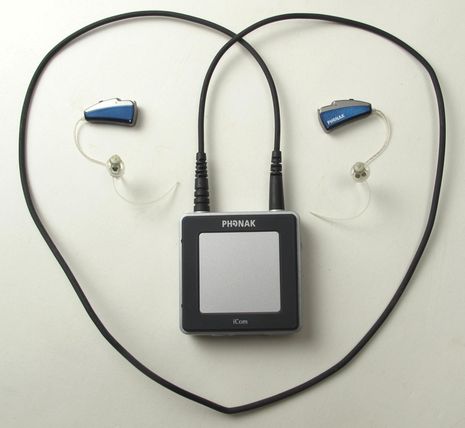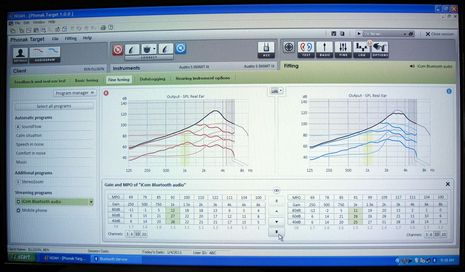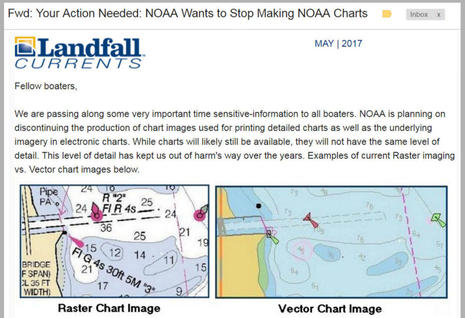My Phonaks; not just aided, augmented!
Yes, I did try to put some “heart” into this photograph of the Phonak Audéo SMART IX hearing aids I’ve been using since early November (often along with that optional Bluetooth accessory). My only significant symptom was difficulty understanding conversation in noisy places, but when tested it turned out that much of my high frequency hearing was gone. I don’t know what caused the damage — that crazy Led Zeppelin concert?…the stint as engineer on the Gulf supply boat? — but there’s no denying the new sounds I’m hearing through the Phonaks. I still delight in everyday noises like the crinkle of paper, and my music collection has come alive. Plus I’m looking forward to the quiet anchorage sounds I didn’t know I was missing, I think that improved hearing is going to help me catch system problems on Gizmo earlier, and I know I’m going to be able to manage cell calls underway better. And it happens that I’m aware of how ineffective hearing aid technology used to be…
My dad started wearing a hearing aid around the time I was born, which is to say soon after spending three years firing howitzers during World War II. He did get to experience the transition from vacuum tubes to transistors — interesting hearing aid history here and here — but the diminishing size of the device he wore on his chest (like the gentlemen below) didn’t make up for its crude linear amplification. I remember trying his ear piece and hearing how the “aid” mashed all ambient sounds together, regardless of where they were coming from. It didn’t remotely compare to undamaged natural hearing. The real revolution in hearing aids has been built on digital sound processing, multiple microphones, wireless communications, and all sorts of other developments…and, frankly, I got pretty emotional when I realized what my father missed…
My Phonaks mainly amplify the sounds I can’t hear naturally — which is why you see the non-occluding ear pieces in the top photo — and they’re listening too. They know, for instance, when I’m in a noisy restaurant and where the sources are, so they can focus on the voice of someone I’m facing while tamping down the crowd. They know too when there’s music in the air and they should retune themselves for maximum dynamics. And they can do tricks like transmitting the input from one ear piece to the other so I get to use both ears when I put a phone to one.
But the main reason I joke that I’m not just aided, but augmented, is that iCom Bluetooth accessory I often wear around my neck and paired to my Android phone. With that set up I can listen to music or podcasts while still being able to hear what’s going on around me, and when a call comes in — taken by just tapping the big button on my chest (which can also mute the music) — I get it in both ears with better fidelity than I’ve ever had with cell calls. I can even listen to an iPad or another Bluetooth source and still take calls as the iCom can handle multiple devices and give the phone priority.
Is the Phonak system perfect? No. It’s wicked expensive and there are areas that could be better, like the dynamic range of the music I hear via the iCom. However, the big cost does include unlimited visits to the audiologist, who in my case is trying to figure out how to improve the sound of that Bluetooth audio program seen below in Phonak’s new Target software. And take a good gander at that software. Dr. Schwartzberg can wirelessly fine tune all sorts of Phonak functions while I’m hearing the results live, change what the buttons on the ear pieces control, even set up a remote control (that I haven’t tried yet).
So saying that hearing aids today aren’t like what your daddy might have struggled with is a huge understatement. But I’m struck by how many people I run into these days who say things like “I’ve been meaning to get my hearing tested” or “Yeah, my hearing sucks too, and I’ve been meaning to try some aids.” Anyone you know? And there’s also the “Well, at least they’re so small no one can see them.” I actually got those blue ones instead of a fleshier color because I don’t think we should be ashamed about such things (a lesson from dad). It turns out they hardly show anyway, but if you see me talking into thin air at a boat show you might realize that I’m seriously accessorized

















Big diesels, locomotives, paper mill and construction equipment have done a number on my ears. Add me to the list of “should go in and have them tested someday”.
How do glasses fit on the ears Ben? Do they have to be wire frames with thin ear sections to share space with the augmenters?
-Doug
Ten Thousand runs a year driving the worlds busiest fire company in East New York, Brooklyn with horn and siren in heavy use blew out the left ear and five years in the other seat took care of the right ear.
Ben, my wife fully understands the situation you are in and has been encouraging me to get tested as well. Can you give us a ball park idea what these high tech aids cost. Like, are they equal to a Broadband radar and chartplotter together?
Thanks for the review – very timely for me.
MaineFog, Over the ear glasses frames do compete for space with the Phonak Smarts, so the thinner the better. You also get a little noise when putting the glasses on. I don’t wear glasses much but my next pair may be those super light jobs that rely more on the side of your head than over the ear.
Richard, the whole Smart IX package was something like an NSE 12, BR24, and installation…about six big ones. I splurged, which is contrary to my normal modus operandi, but this seemed like the right place to go whole hog. There are less expensive Audeo Smart models and less expensive lines, but I was taken with the feature set. Besides the wireless stuff, which is quite valuable to me, they have something called SoundRecover. My very high frequency hearing is so bad that it can’t really be aided, but SoundRecover moves lower frequencies down a bit and thus fools my brain into “hearing” a full dynamic range. I think it works.
Ben
Got a set of those hearing aids from the VA this last fall. $5,000 for the pair, but my hitch in Vietnam and my medals qualified me for a free set.
I learned that losing my ability to hear high freq sounds is natural to us aging vets, It goes along with “selective hearing” that our wives blame us for. As we get older we find it increasingly difficult to hear women’s voices. That is also natural We’ve never understood them, so going deaf has been a blessing. The examiner who tested me told me to tell my wife, the aids will not solve the communication problem we are experiencing, she still needs to face me and talk to me in the same room, not from the other end of the house or the boat.
David
Thanks, David. Gary Schwarzberg pointed out to me that “there’s a difference between hearing and attention” and I’ve been meaning to send him a link to this cartoon, which is popular in my household and should probably be every audiologist’s wall
http://www.cartoonbank.com/2000/im-sorry-dear-i-wasnt-listening-could-you-repeat-what-youve-said-since-weve-been-marri/invt/119411/
I’ve been wearing hearing devices since 1985 would be totally lost without them. My hearing loss was caused by a rather large explosion that took place very close to our position in Vietnam I receive VA compensation for my loss. When you look at my audio grams it really astounding how much I lost. My loss is a flat line 65 dB left and 59 db right. I have to use the strongest in the ear technogoly available. The VA replaces mine every five years.
The technology has really improved over the years.
Tom (bwp)
I have a very similar problem to yours Ben, in that I am unable to distinguish individual conversations out of a group of people, but my hearing in itself in the quiet is fine, although I do have mild to moderate Tinnitus. My Doctor says that it is all caused by a lifetime of playing keyboards and guitar in semi-pro rock bands.
I may very well give these a shot, if only for places like pubs clubs, meetings etc.
Just getting old chap.
Cheers
Steve
I’m a woman in my mid 50s; have been wearing aids since my late 40s — apparently a genetic thing. I’d had my hearing tested and was told years before that I qualified for hearing aids, but somehow couldn’t face up to it.
It’s outrageous how expensive they are — outrageous because the cost (and vanity) keep so many people from getting them. It’s a safety issue as much as a lifestyle or social issue.
If you are regularly on a boat (or just as important, if you drive!), and you have hearing loss, please get hearing aids. The problem of hearing loss is that, unlike bad eyesight (which I also have!) when you know something is blurry, you don’t know that you haven’t heard something or that you’ve misheard it. Hard enough to distinguish “15” from “50” over a radio. You won’t hear horns or whistles. You won’t hear a yell. You can’t communicate in a storm. You won’t hear the engine suddenly do something odd.
People think they’ll seem old if they wear aids. They don’t realize that they already seem old to people who need to repeat everything two or three times or because they’re apparently crotchety — because they don’t know they’re talking over other people.
I rather like my bionic ears. I’m the one who isn’t bothered by noisy restaurants — I have a program for that. And I can always turn up the volume if I want to overhear a particularly interesting conversation!
I use Phonaks too and like the bluetooth technology with TV and cell phones. Phonak has a Bluetooth transmitter for non-Bluetooth equipment such as stereo and TV, but it requires AC output. It would be nice to find a 12 volt DC Bluetooth xmitter for audio marine equipment like VHF’s that have external audio. While on the subject of communication, the issue of captain/crew communication should be revisited. You once wrote about the Bluetooth RocketFish head phones which work, but not well for those who wear hearing aids. I have now switched to Eartec Simultalk 24G which is much better.
Hi Mike, The model of TVLink that I got along with the iCom is powered by USB cable, so it would be easy to run with 12 volt boat power. I can also charge the iCom with a USB cable or drop it into the TVLink for charging. to charge the iCom or mount it in the TVLink for charging.
Standard Horizon makes fixed and handheld VHF radios with Bluetooth headset ability, and I think it will work with an iCom. I can’t try it because I returned the test equipment, but when I had an HX760S I was able to pair it with my Motorola ROKR bluetooth headset. And everything else that previously worked with the Rokrs works with the iCom.
Finally I’m not sure what you mean by RocketFish head phones as I don’t recall using or writing about them. There seem to be a wide variety of Rocketfish, one just like my Rokr’s, but none seem to be walkie talkie systems like the Eartecs.
Time for an update! While I liked the iCom Bluetooth connection (seen above) between my hearing aids and phone, I’m now using a new ComPilot that’s much better. It’s easier to connect to phone, iPad, etc. and it has significantly better sound quality and longer battery life. It also lets me control volume on the Phonaks and access voice commands on the phone, and has more features. It’s a total winner: http://goo.gl/9kLh6
Hearing aids are expensive and not compatible with water. Phonak does have some aids which are “WaterResistant”:
(from http://www.phonak.com/com/b2c/en/products/hearing_instruments.html )
Thanks, Norse. I didn’t know about the water resistent option. I wonder if Phonak is using one the nano waterproofing technologies that are coming to smart phones, etc.
But I’m hoping not to replace my Audeo Smart hearing aids any time soon, and I would not hesitate to wear them in a boat like Lucas’s…unless I thought there was a significant chance of dunking my head. I always wear them around my boat and tender, and have a few times put my head under a shower before remembering that they were still on. No damage yet.